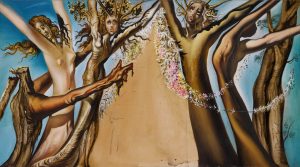During his eight-year residency in the United States in the 1940s, Salvador Dalí continued his ceaseless quest of creation. Among his numerous projects during this time were several ballets to which he contributed in varying modes—from set and costume design to concept and creation. Étude pour une toile de fond pour Tristan Fou (Acte I) is a testament to his work on the production of Tristan Fou—Mad Tristan—which he created alongside Leonide Masssine.
Tristan fou—as the artist decided to rename the opera, lending it a rather psychoanalytic feel in line with Surrealist preoccupations—premiered on 15 December 1944, and was performed by the International Ballet in New York. Léonide Massine, the principal choreographer of Sergei Diaghilev’s Ballets Russes whom Dalí met in the mid-1930s, choreographed the ballet. This spectacle was executed during one of Dalí’s most prolific periods experimenting with the interdisciplinary arts.
Based on Wagner’s grand and dramatic opera Tristan und Isolde, which premiered in 1865, Dalí’s reinterpretation of the famous romance is a Surrealist twist on an iconic tale of Western culture. The present oil was used as a design for the monumental backdrop which hung during the first act of the production.

In the visual design of the ballet, Dalí not only creates a parallel with the traditional love story between Tristan and Isolde, the latter dying of grief in the final act of the opera, but also echoes Classical myth and especially the story of Apollo and Daphne as retold in Ovid’s Metamorphoses and brought into seeming tactile reality by Bernini in the 1620s.
The female figures in the present work are in the process of transforming into trees. While the three tree-figures that still bear recognizable representations of female heads would logically seem to be the most human of the figures depicted, in fact it is the tree at left, whose upper half is broke at a version of a neck and the two trees at far right that share a passionate embrace, that have the most plastic qualities of the grouping, despite their almost complete lack of human attributes.
The tale of Tristan and Isolde is one of the great doomed romances of all time. Often conflated with the later love triangle of King Arthur, Guinevere and Lancelot and with echoes of potions and tragic death found in Shakespeare’s Romeo and Juliet, the legend of Tristan and Isolde took various guises throughout history. Largely forgotten for centuries, it was revived alongside the Arthurian legends in the late nineteenth and early twentieth centuries. Depicted frequently in the visual artists, including lavishly illustrated publications, the tale would have been well known to Dalí who incorporated it into his creative process.
Some of the artist’s favorite tropes are included in the present work and in the larger production of the ballet as a whole. In his costume design Dalí was able to again include his beloved flower-headed female figures, whose floral aspects were found not just bursting from their skulls but inhabiting their entire dress through the each ruffle of their tutus. Edwin Denby, a journalist of the time, tells of the way in which “fantastic backdrops, costumes, stage effects tumble out over the stage for half an hour in frenzied profusion… a proliferation of decoration no one in the world but Dalí can rival”. In the present painting, Dalí invokes a range of rich and varied imagery, erotic, human and emotional in a work appealing to the all the senses.
Artist: Salvador Dalí (1904 – 1989)
Artwork: Étude pour une toile de fond pour Tristan Fou (Acte I)
Date: 1944
Medium: Oil on canvas
Dimension: 26.8 × 48.2 cm
Estimate: 800,000 – 1,200,000 USD
Property of a private East Coast Collection
Source: Sotheby’s







